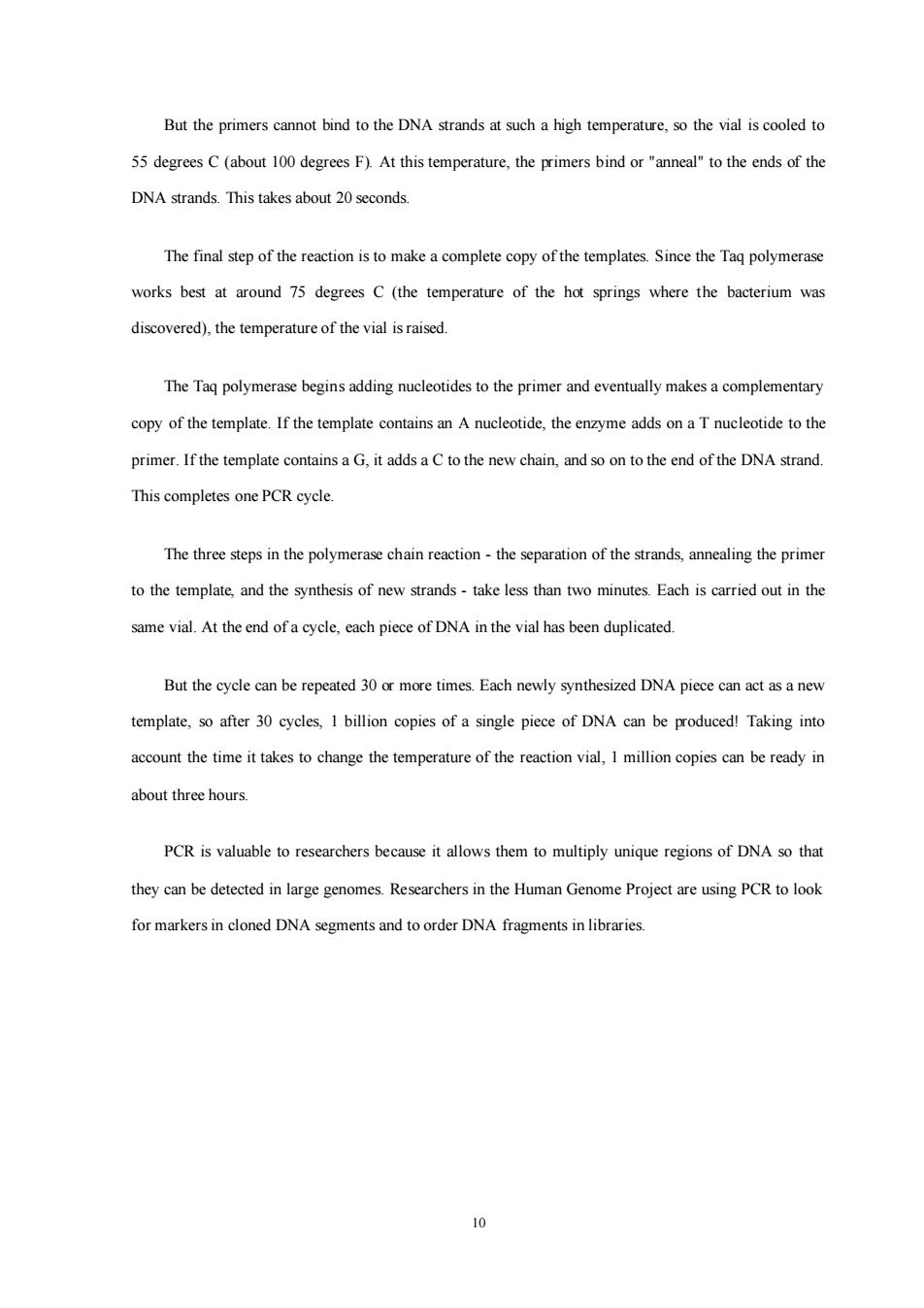正在加载图片...

But the primers cannot bind to the DNA strands at such a high temperature,so the vial iscooldto 55 degrees C(about degrees F)At this temperature.the primers bind or"ato the ends of the DNA strands.This takes about 20seconds The final step of the reaction is to make a complete copy of the templates.Since the Taq polymerase works best at around 75 degrees C(the temperature of the hot springs where the bacterium was discovered),the temperature of the vial is raised. The Taq polymerase begins adding nucleotides to the primer and eventually makes a complementary copy of the template.If the template contains an A nucleotide,the enzyme adds onaTucleotide to the primer.Ifthe template containsaG.it new chain,and so on totheend of the DNA strand This completes one PCR cycle The three steps in the polymerase chain reaction-the separation of the strands,annealing the primer to the template,and the synthesis of new strands-take less than two minutes.Each is carried out in the same vial.At the end of a cycle,each piece of DNA in the vial has been duplicated. But the cycle can be repeated 30 more times.Each newly synthesized DNA piece can act as a new template.so after 30 cycles,I billion copies of a single piece of DNA can be produced!Taking into account the time it takes to change the temperature of the reaction vial,1 million copies can be ready in about three hours PCR is valuable to researchers because it allows them to multiply unique regions of DNA so that they can be detected in large genomes.Researchers in the Human Genome Project are using PCR to look for markers in cloned DNA segments and to order DNA fragments in libraries. 10 10 But the primers cannot bind to the DNA strands at such a high temperature, so the vial is cooled to 55 degrees C (about 100 degrees F). At this temperature, the primers bind or "anneal" to the ends of the DNA strands. This takes about 20 seconds. The final step of the reaction is to make a complete copy of the templates. Since the Taq polymerase works best at around 75 degrees C (the temperature of the hot springs where the bacterium was discovered), the temperature of the vial is raised. The Taq polymerase begins adding nucleotides to the primer and eventually makes a complementary copy of the template. If the template contains an A nucleotide, the enzyme adds on a T nucleotide to the primer. If the template contains a G, it adds a C to the new chain, and so on to the end of the DNA strand. This completes one PCR cycle. The three steps in the polymerase chain reaction - the separation of the strands, annealing the primer to the template, and the synthesis of new strands - take less than two minutes. Each is carried out in the same vial. At the end of a cycle, each piece of DNA in the vial has been duplicated. But the cycle can be repeated 30 or more times. Each newly synthesized DNA piece can act as a new template, so after 30 cycles, 1 billion copies of a single piece of DNA can be produced! Taking into account the time it takes to change the temperature of the reaction vial, 1 million copies can be ready in about three hours. PCR is valuable to researchers because it allows them to multiply unique regions of DNA so that they can be detected in large genomes. Researchers in the Human Genome Project are using PCR to look for markers in cloned DNA segments and to order DNA fragments in libraries